Green Kerala
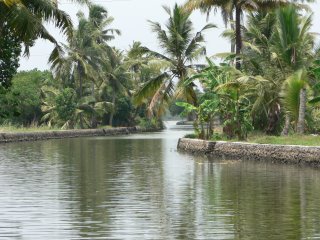
We spent a long weekend in Kerala--a couple of nights in Cochin, and one on a houseboat tour on out of Alleppy, about an hour and half drive from Cochin.
The houseboat tour took us into the backwaters of Kerala, where we had a chance to observe the rice farmers, fisherfolk, and coir workers who live along the waterways, not to mention some of the most lush and verdant landscape in the country--overwhelmingly green. We had a one-bedroom (air conditioned from 9 p.m. to 7 a.m.) boat, with a crew of three including a cook. These boats, which are now built for tourism, used to be rice haulers, with the rice stored in the hold and the living quarters on the top. Kerala rice is quite different from any we've had elsewhere---the grains are almost the size of orzo. Kerala cuisine is heavy on coconut and bananas, and we even had fried bananas as an afternoon snack.
The river is used for washing clothes, utensils, and for bathing---we saw quite a few people taking baths along the way. (more pictures on Flickr up top).
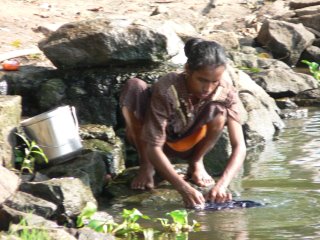
This area is called the "Venice of India," because it is a series of waterways where the only way to get around is by boat. The government provides ferries that get people around, and there are government schools along the route as well, going up to high school.
Kerala does not have much industry besides the traditional trades and tourism, because the politics are heavily communist and labor tends to be quite militant here. Interestingly, the state also has one of the highest literacy rates in the country. Recently, they have tried to attract IT and other industries here, but it seems to be tough going. Many young Keralites leave the region and head over to Tamil Nadu for employment.
Kerala is also heavily Syrian Christian, so called because of the influence of Thomas the Apostle, who supposedly came to India in 52 A.D. and converted both Hindus and some of the Jewish settlers who had preceded him (this history is in dispute). Cochin, in fact, has the oldest Jewish community (now mostly dispersed) in India. We visited the synagogue at the end of the street called Jewtown; here you can see Marty in front of the ark.
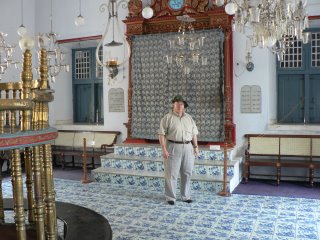
Due to the imported Chinese flooring (every tile is unique) you are required to remove your shoes before entering the shul:
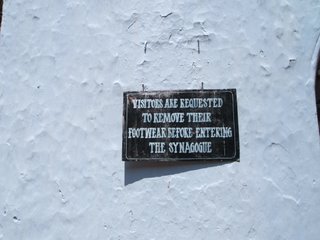 Only a few Jews remain in Cochin, so the synagogue rarely gets a minyan, except on holidays, and is mostly a tourist sight---in fact, there were a surprising number of visitors when we went there, both Indian and Western. Along the way, we stopped at Sarah's Embroidery, where Sarah herself--a sprightly octagenarian--presides. She makes a number of hand embroidered items, such as Sabbath bread covers, yarmulkes, and other items. Today, these are among the few
Only a few Jews remain in Cochin, so the synagogue rarely gets a minyan, except on holidays, and is mostly a tourist sight---in fact, there were a surprising number of visitors when we went there, both Indian and Western. Along the way, we stopped at Sarah's Embroidery, where Sarah herself--a sprightly octagenarian--presides. She makes a number of hand embroidered items, such as Sabbath bread covers, yarmulkes, and other items. Today, these are among the few
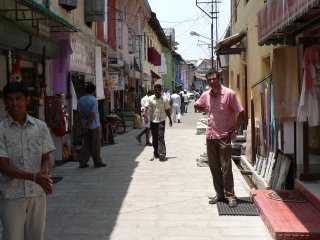 Jewish items available on Jew Street. Jewtown, which used to be lined with Jewish shops, is now mostly Christian, with shops catering to tourists offering everything from clothing to fake antiques. Merchants literally lie in wait (picture to the right) cajoling you to "come inside and see my goods, no obligation to buy."
Jewish items available on Jew Street. Jewtown, which used to be lined with Jewish shops, is now mostly Christian, with shops catering to tourists offering everything from clothing to fake antiques. Merchants literally lie in wait (picture to the right) cajoling you to "come inside and see my goods, no obligation to buy."
I visted your blog on Kerala. Its pretty interesting. All the photos and descriptions there transport me to this divine land.
I am from Assam and I am a D.Phil researcher in Delhi University. I am researching on Internet Sociology. Consequently, I am interested to get the opinion for serious bloggers like you.
Could you kindly pull off some time from your schedule and visit my research blog http://nmsoc.blogspot.com and provide me a detailed writeup of how exactly you started blogging --who compelled you. Are they issues, persons or some other latent desire inside you. I would appreciate if you send me the complete story. It will be a great help.
You can reach me at newmedia.soc@gmail.com
<< Home



